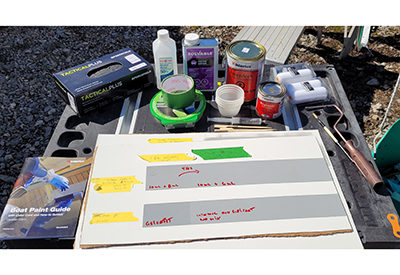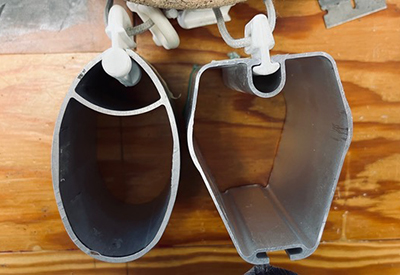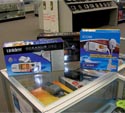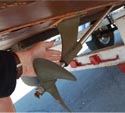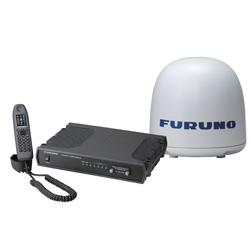Folding and Feathering Props
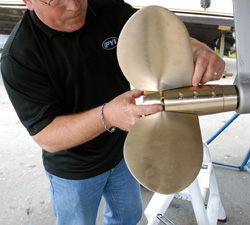
Story and Photos By William Kelly
Under sail, these marvels of engineering deliver significantly less drag and greater speed than their traditional fixed-blade cousins.
When I started sailing, the economical way to reduce propeller drag on a cruising sailboat was simply to install a two-blade prop. This worked fine – we had one on our 35’ sailboat for almost 30 years. Mind you, it didn’t provide a lot of push in steep seas and headwinds, and we often used the mainsail to help punch us through a chop.
Now we have a bigger boat and a three-blade prop behind our 100-hp engine makes more sense. However, under sail, a fixed three-blade prop is reported to have the same effect as dragging a bucket in the water – and two buckets if the transmission is left in gear as most engine manufacturers recommend. This can reduce speed under sail by more than a knot and add hours of sailing time to an extended passage.
Fixed props do have several advantages over folding and feathering models, however. They are simple, less expensive, require less maintenance, produce less noise and vibration, and are slightly more efficient in forward gear because their airfoil sections provide better lift than flat-sided feathering props. Like most things on boats, it’s a trade-off: the reduced drag of a folding or feathering prop against their higher cost and maintenance.
 For many sailors – cruisers and racers – the trade-off seems worth it. With more manufacturers entering the market, costs have come down and reliability has improved. Although feathering and folding props still price out at two to five times (or more) higher than their fixed-blade cousins, tests show a feathering prop reduces drag by more than 90 per cent and a folding prop by almost 100 per cent. This translates to a significant improvement in sailing speed – especially in light winds, which are typical in most Canadian waters in the summer months. Reduced drag also improves a boat’s pointing ability, which could make a big difference when clawing off a lee shore.
For many sailors – cruisers and racers – the trade-off seems worth it. With more manufacturers entering the market, costs have come down and reliability has improved. Although feathering and folding props still price out at two to five times (or more) higher than their fixed-blade cousins, tests show a feathering prop reduces drag by more than 90 per cent and a folding prop by almost 100 per cent. This translates to a significant improvement in sailing speed – especially in light winds, which are typical in most Canadian waters in the summer months. Reduced drag also improves a boat’s pointing ability, which could make a big difference when clawing off a lee shore.
Since these props were first introduced in the mid-1970s, issues of reliability and performance have largely been addressed through improvements and upgrades. Reversing with a folding or feathering prop was sometimes a heart-stopping experience back then. But some of today’s props offer better stopping time and better pull in reverse than a standard fixed-blade wheel.
Choosing a Prop
The question for many sailors is which one to buy? A folding prop does what the name implies – when not in use the blades fold down over the end cap. The blades are usually geared so they stay tightly folded and out of the water flow while under sail.
The blades of feathering props are mounted at right angles to the prop shaft and rotate on a hub or boss. The torque of the prop shaft turns the blades at an angle to provide either forward or reverse thrust depending on which gear is in use. If the boat is moving through the water with the shaft locked in gear and the engine off, the absence of torque allows the blades to feather so only the slim leading edge is left in the water flow. Both types of props require the engine to be off and put into gear momentarily to make them fold or feather.
Your options in props will vary depending on boat size. The owner of a smaller boat with a less-powerful engine might consider a wide range of props, including the Kiwi Prop with glass-reinforced plastic blades. Owners of larger boats have fewer options because some props are unable to handle engines over 100 hp. Owners of traditional full-keel sailboats will likely be limited to feathering props, as folding models usually don’t fit in the small apertures found on these hulls. However, most modern boats have a fin keel and aft rudder, with ample room for either type of prop.
Max Prop
 For our Tayana 48 with its 100-hp engine I chose a feathering Max Prop. The manufacturer offers a few variations (see sidebar) but I ended up buying the original or “classic” Max Prop which meant, among other things (such as being less expensive), prop adjustments are internal and the end cap and central gear must be removed to adjust pitch. An experienced diver may be able to do this work in the water, but generally these adjustments need to be done during a haulout. The newer Max Prop “Easy” can be adjusted externally – a feature now offered by most manufacturers of feathering props. Installation of this new generation of feathering props is also simpler.
For our Tayana 48 with its 100-hp engine I chose a feathering Max Prop. The manufacturer offers a few variations (see sidebar) but I ended up buying the original or “classic” Max Prop which meant, among other things (such as being less expensive), prop adjustments are internal and the end cap and central gear must be removed to adjust pitch. An experienced diver may be able to do this work in the water, but generally these adjustments need to be done during a haulout. The newer Max Prop “Easy” can be adjusted externally – a feature now offered by most manufacturers of feathering props. Installation of this new generation of feathering props is also simpler.
When we took our shiny new bronze Max Prop out of the box, it was a wonder to behold. With finely machined parts that fit together like a Swiss watch, it’s an engineering marvel. Vancouver sailor Wally Raepple has had a Max Prop for many years on his C&C 30 and says, “In my opinion, it’s a work of art. If it weren’t hanging in the water under my boat, it would be on the mantle.”
Fred Hutchison of PYI, North American distributor of the Max Prop, oversaw the installation of our new prop and offered a few words of advice. However, the manual is very good and provides all the instructions you really need. Although the Max Prop seems complicated, it’s actually fairly easy to install. Key points include making sure the hub is fully into the prop shaft and the shaft nut is securely tightened. Also, ensure the locking pin for the nut is installed as shown in the manual and all setscrews are tightened, with the cotter pins butting against the spindle or end cap. I took photos at each step so that if I wanted to check any aspect along the way – such as making sure the pitch angle was set correctly – I had a photo as confirmation.
In the water, the prop worked fine, although I may have put in too much grease because it seemed to hesitate the first couple of times I tried to feather it. However, it settled out and eventually feathered easily. I normally sail with the engine in neutral because the shaft doesn’t turn once the prop is feathered. Under power, I noticed a slight whine at certain RPMs but this is apparently normal.
There is discussion in various online forums about whether feathering props, with their flat blades, should be set up with more pitch to compensate for the lack of the airfoil section on fixed props. The original prop fitted to our boat was a 19 x 12, but I added another inch of pitch that helped us reach cruising speed at a slightly lower RPM and didn’t affect the ability of the engine to reach maximum RPM – an indicator that it is not overpitched.
The Max Prop, like most other feathering and folding props, requires annual servicing to clean, grease and replace the anode. The last is a critical step – the prop is a very expensive piece of equipment to replace if it becomes corroded.
William Kelly’s sailing adventures have taken him up the West Coast as far as the Gulf of Alaska. With Anne Vipond, he is the author of Best Anchorages of the Inside Passage.
Prop Options
Here are a few of the folding and feathering props available in Canada:
AUTOPROP: Works differently from most feathering props in that the blades swivel or rotate independently from being feathered to being under power. The amount of twist in the prop depends on engine RPM and load, providing a variable-pitch option. www.autoprop.com
AUTOSTREAM: Manufactured in Australia, this feathering prop has been around for decades and is highly regarded for its all-stainless steel construction. Offers separate pitch settings for forward and reverse, helping to reduce prop walk. Local dealer is West By North, which also markets the excellent Campbell Sailer fixed prop. www.westbynorth.com/AutostreamAdvantages.aspx
FEATHERSTREAM: This UK product is fairly new but there are good reports of its ease of adjustment (external), performance and price. Sold in Canada by Caledon Boatworks of Ontario. Website: www.featheringpropeller.com
FLEXOFOLD: Hub and blades of this folding prop are made of nickel-aluminum-bronze, significantly stronger than bronze; stainless steel pins keep the blades securely in place. Made in Denmark since the late 1990s, it rates, according to a report in Yachting Monthly in 2009, among the best of all feathering or folding props for stopping and forward thrust. www.flexofold.com
GORI: A pioneer of folding propellers in the mid-1970s and still with many advocates. Manufactured in Denmark and available in Canada through US distributor AB Marine. www.ab-marine.com
KIWI PROP: Designed in New Zealand over a dozen years ago, this prop is unique in using composite plastic for its blades, eliminating the risk of corrosion. The company has an office in Toronto. www.kiwiprops.com
MAX PROP: An early leader in the design and manufacture of feathering propellers, this company enjoys a loyal following and continues to upgrade their product. In addition to the “Classic” there is now the externally-adjustable “Easy,” the variable-pitch “Ecowind” and the five-blade “Whisper, also externally adjustable. www.pyiinc.com
VARIPROP: This German-made feathering prop comes in variations of two to four blades and boasts one of the shortest hub lengths to fit smaller apertures. A newer model, the Variprofile, offers pitch adjustment for forward and reverse to help reduce prop walk. This company also designed the Varifold, a folding variation. These props have Canadian distribution. www.nautilusvariprop.ca
Photo Captions
Photo 1: Fred Hutchison of PYI, North American distributors of the Max Prop, fits end cap and blades onto the spinner. Black markers on spinner and hub ensure blades are positioned properly.
Photos 2 and 3: Before and after: Old fixed-blade prop was worn and cracked at base. New Max Prop in pitched position.

